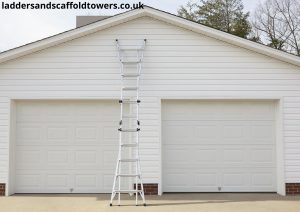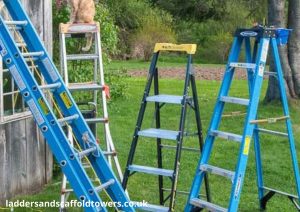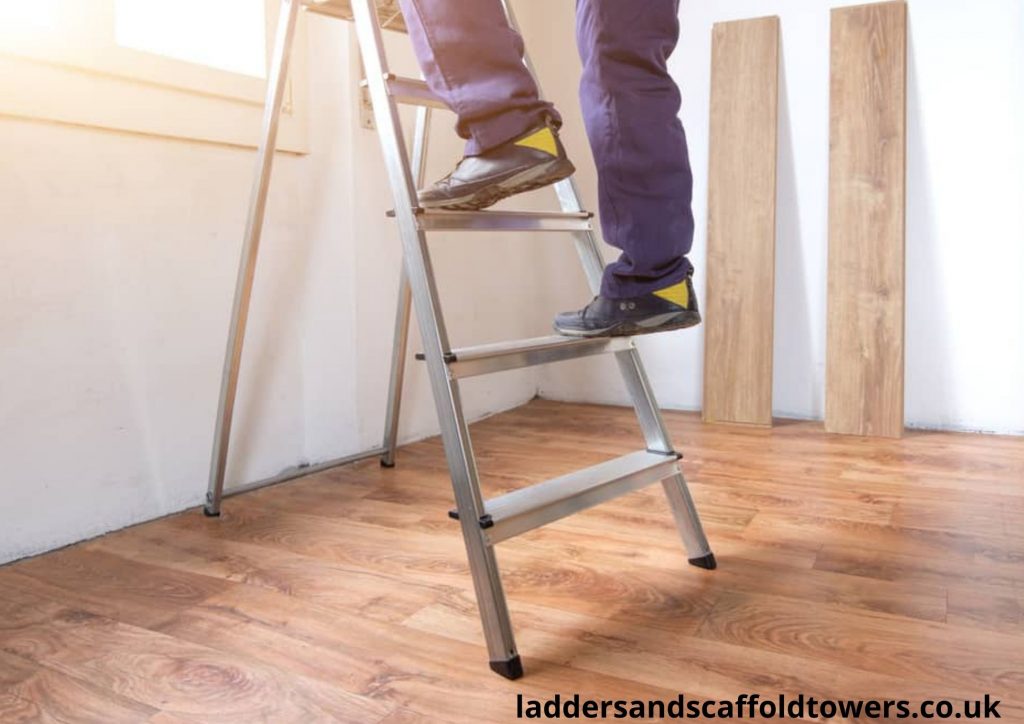Ladders have served mankind for thousands of years, as shown by cave drawings in Spain of people climbing ladders, dated 8,000 BCE. The first articulated ladder with steps (not horizontal rods) was designed and manufactured in the late 1800s by John Basely of Ohio, USA. It could be folded and stored away…and you thought that was a current invention!
Today we are sharing a ladder grades guide, what they mean and when to use each one to help you in your small or large projects. We will also discuss what the difference is between type 1 and type 2 ladders.
The presence of ladders in society
We will never know who invented the first ladder thousands of years ago, but that invention has helped us reach new heights. Whether you are painting a house, doing street art, cleaning a gutter or rescuing someone from a fire, you are using a stepladder. The types of ladders available have evolved dramatically in modern times to increase health and safety as well as efficiency and storage.
Getting your ladder choice right means using a ladder grades guide and understanding what they mean. Knowing when to use each one is a formula of height plus safety, efficiency and benefits.
There are multi-purpose, lightweight ladders available which are great for smaller projects, homeowners or handyman businesses. There is a point at which the demands of a project will require specific ladders. Let’s look at the ladder grades guide, what they mean and when to use each one.
Ladder grades guide, what they mean and when to use each one
The classification of ladders used to fall under the British Standards (BS) and the ‘old’ EN131. But in 2018, the United Kingdom market took on the new EN131 standards as the BS2037; BS1129 and EN131 classifications were deemed to have some unacceptable gaps.
The new EN131 standard was published throughout the European market in January of 2018. The clearer definitions within this new revision addressed factors such as the stability of ladders, their usable lifespan, as well as a recommendation on the appropriateness of use or application.
The first division of the classification into sections starts with:
- EN131 Professional, which is for commercial use. An example of this is our BPS Single Section Professional Roof Ladder.
- EN131 Non-Professional, which is for use in homes (e.g. fetching something from your top cupboard). An example of this is our Trade Platform Step Ladder.
The grading of ladders is primarily divided up into Class 1, Class EN131 and Class III. These classes were designed to enhance the health and safety parameters around the use of ladders. The class will specify the recommended safe working load that the particular ladder equipment was manufactured to cope with.

Definition of terms and usage
The definition of a ‘safe working load’ is the combination of
- The weight of a single, certified or qualified person.
- The weight of the equipment required to effect the task, e.g. twenty-five litres of paint (thirty kilograms) and painting equipment (five kilograms).
- The total of all these weights is the maximum load.
The class of ladder also attempts to guide users as to the recommended application for a ladder, such as:
- Heavy Duty Industrial Use
- Commercial Light Trade Use
- Light Domestic Use
You may remember that previous classifications referred to ‘Duty Ratings’ of ladder equipment. The Duty Rating used factors such as:
- The frequency of use.
- The environment in which the equipment was used.
This original set of classifications was designed and published by the British Standards Institution (the non-profit, national standards body of the United Kingdom).
Overview of classification parameters
With the cross-union standardisation and borderless trading that the EU brought about, the European Ladder Certification Standard was implemented and the original Class EN131. The Class EN131 standard superseded the BS Class II classification.
At that time, the Department for Business, Energy and Industrial Strategy (previously called the Department of Trade and Industry) published an explanation of the standards via a comparative table. They compared the British Standards Duty Ratings and the European Ladder Certification Standard at its maximum load.
| Classification | Duty Rating | Maximum Load | Application |
| Class 1 | 130kg | 175kg | Industrial |
| Class EN131 | 115kg | 150kg | Commercial |
| Class III | 95kg | 125kg | Domestic |
Subsections of the ladder grade classes
This set of classifications branches out into subsections and, therefore, contain various British Standards which are specific to a type of ladder equipment. Examples of this are:
- BS 1129:1990 – This relates to wooden ladders, steps, trestle ladders as well as lightweight staging’s (also called LWS, these are platform systems providing a working platform or a bridge over a gap).
- BS 2037:1994 – This relates to metal and aluminium ladders, steps, trestle ladders and LWS.
- EN 131 – This classification relates to wooden, plastic, aluminium and steel ladders or steps. You will find specifics such as:
- Dimensions
- Labelling and markings
- Deflection test requirement
- Torsion test requirements
- Rigidity test requirements
- Straightness test requirements
- Loading test requirements
- Performance test requirements
One of the primary labelling requirements is the attachment of the standardised colour coded markers. The colour coding on each ladder should be easy to see and will immediately identify what class they belong to:
- Class 1 ladders – The market norm for this class is a blue label.
- Class EN131 – These ladders will be marked green or yellow.
- Class III – The equipment within this class is marked with a grey label.
A handy development has been the colour coding of the feet of the ladder so it is easy to spot from a distance and while in storage. It should also be in the user manual and on any safety labels.
Ladder grade class guide details
The Class 1 and Class EN131 are sometimes referred to as Type 1 and Type 2. In this section, we look at what is the difference between type 1 and type 2 ladders as well as Class 3 / III.
Class 1
Ladders that require the highest ratings of strength, durability and quality for their operational use will be placed in Class 1. You should choose this class of equipment if your project tasks are heavy-duty industrial applications. Because the equipment is expected to be in a heavy-duty industrial environment, and therefore will be expected by default to perform relative tasks, the weight rating given is 175kg as the maximum load. There is no higher rating.
Class EN131
This classification applies to ladder equipment produced or used all across the European Union and the United Kingdom. It replaced the previous classification: Class II Ladder Standard. Some companies might label or categorise equipment with the nomenclature BS EN131. If you or your team will be needing a ladder for light commercial work, this is the class you should be looking at. In addition, if you are a serial DIYer who makes extensive use of their ladder, you should definitely be looking at this sturdier opinion.
Class 3 / III
This is a ladder that seldom sees the light of day. It will serve you well for the once a month light bulb change or pulling out those tucked away items at the tops of cupboards. Do not whip this ladder out in an emergency to take with you to a site if you are a tradesman. The stays and joints could buckle or bend, even from closing it incorrectly.
An EN131 ladder is probably a better bet to use at home because, no doubt, a tradesman will want to borrow it one day, or you might decide to do a big tree trimming project one year.
Category warning
One thing that you should remember is that the classes that ladders are assigned to tell you what the minimum requirements are for a ladder. A top quality, market-leading ladder should surpass these standards by far, not match them.

Are ladders under the old ladder grades now “illegal”?
The new classification of the ladders has not nullified the compliance of ladders that were previously purchased under the classifications BS2037 and BS1129. Your previously compliant ladders remain compliant and suitable for their related application as long as they are well maintained and do not pose a health and safety issue. So no panic is needed as you do not need to rush out to ladder suppliers and invest in an entire new stock of ladders.
Regardless of classifications and compliance, the key thing is to ensure that your ladders are frequently reviewed and checked for wear and tear, unexpected damage, corrosion or material failure. As with all your equipment, health and safety are enhanced and your investment ROI is increased if you schedule services into your diary and keep all the components in good working condition.
If you need any help working out whether your ladder at home is compliant or safe, don’t hesitate to give us a call.
What was the impact of ladder grades on manufacturers?
There is, of course, an impact on the manufacturers of ladders, including their stockpile, but a grace period was announced, which makes commercial sense. This grace period is sufficient time for the manufacturers to redesign their production line and engage with existing or new raw material suppliers about the compliance needs of this new classification. Their new production will successively convert to the new classification requirements as well as their labelling, marketing material and usage guidelines.
Going forward, every step ladder that is made or sold in the UK or the EU must have every component and fabrication process compliant with the classifications. Each ladder must also be correctly classified before it leaves the factory.
The regulations and compliance parameters apply to the full range of ladder types, such as:
- Portable ladder types
- Step ladders
- Platform steps
- Extension ladders
The regulations and compliance parameters do not apply to the following range of ladder types:
- Specialist single-use ladders
- Loft ladders
- Window cleaning ladders
- Fixed access ladders
How to use a ladder safely
By checking the grade of your ladder has already started you off in the right safety direction. Now that you have the correct ladder class, here are some practical tips on how to operate effectively and safely.
Length – Believe it or not, most people do not select the correct length of ladder. Remember, the top rung of a ladder is not a footrest; it can serve as a hand grip or holder onto which you can hook things. You should measure the length up to the penultimate step or rung (second to highest rung/step). Using the top rung or step increases your chances of falling as you have no side frame to press your leg against, and it is impossible to bend that far over to get a handgrip.
Gaps – Not using the top rung includes the instances when you are climbing up to a point in a structure and then stepping off the ladder and onto the destination structure. In these instances, it is critical that you choose a ladder that is actually a foot higher than your destination “landing point”, and the landing point should be the support point. This means that the ladder will be touching the structure you will be stepping onto and then extending a foot higher. If you leave a gap between the landing and the ladder, you exponentially increase the risk of a serious fall.
Overlap – Extension ladders have such versatility, no wonder they are so popular. Whilst it is very exciting to pull a ladder out to its impressive full length, it is still best practice to pull the ladder out to a length that only exceeds the contact/support point by one foot. If you overextend it and the uppermost section reaches more than three feet past the top contact point, then you would have created a lever with that huge overlap. What might occur is that the force on the top, when amplified by the factor of the lever, could cause the lower section to swing out and cause serious falls and injuries. Extend with caution.
How to inspect your ladder
Before leaping onto your ladder, or rather stepping cautiously onto your ladder, you should take a few minutes to inspect it. That is much more convenient than a lifelong back injury. If you are using ladders commercially, then it is too late to inspect a ladder on site. Regular inspections should be scheduled as well as there being a pre-use inspection each time.
Feet – The first thing to check would be its “feet”. The rubber covering might look great from the top, but it is essential to check the degree of wear and tear on the underside. These feet are critical for preventing life-threatening slips of the equipment. If the rubber seems to be thick enough, you should next check for splits in the material. A significant split could cause the rubber covering to be rubbed off one foot during use which is very dangerous.
Cleaning – Cleaning equipment is particularly important if there are multiple users of pieces of equipment. If the previous user has not cleaned it and has left grease or spilt oil on upper steps or rungs, this is a real safety threat. Sand and aggregates can also cause a slip, so clean each step or rung.
Components – All the rivets, nuts, bolts, handles, hooks, guides, etc. must also be checked for strength, wear and tear and corrosion.
Our experts are at your disposal for discussing ladder grades guide, what they mean and when to use each one. Call for advice today or invest in new ladders here.
No related posts.



